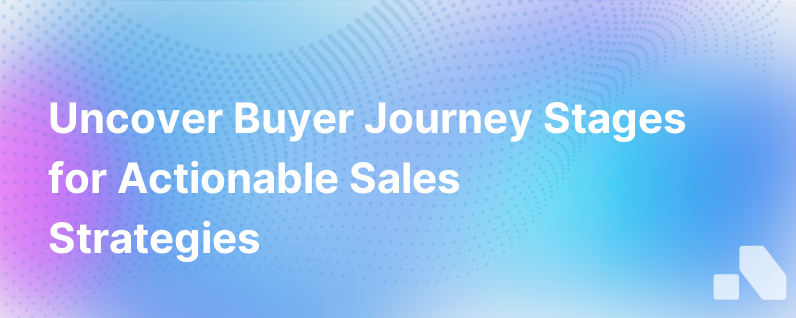
In the world of B2B sales and marketing, understanding where your buyers are in their journey is not just useful — it's critical to success. Being able to pinpoint the precise stage of the buyer’s journey for each prospect or customer helps tailor strategies, personalize engagement, and move opportunities through the pipeline more effectively.
Here's your comprehensive guide to uncovering where your buyers are on their journey and making that information actionable.
The Buyer's Journey Unveiled
Broadly, the buyer's journey consists of three stages: Awareness, Consideration, and Decision.
- Awareness Stage: The buyer realizes they have a problem that needs solving.
- Consideration Stage: The buyer defines their problem and researches options to solve it.
- Decision Stage: The buyer chooses a solution.
While it might seem clear-cut, in practice, the buyer’s journey is more intricate and less linear. Knowing the nuances at each step is the key to successful engagement.
Identifying the Journey Stage
1. Data Analysis and Lead Scoring: Lead scoring involves assigning values, often in the form of numerical points, to each lead you generate for the business. You can score leads based on the actions they’ve taken and information they’ve provided. This practice helps teams qualify leads and determine where they are along the buyer's journey. Through predictive analytics, lead scoring systems can often pick up on subtle signals that indicate where a buyer might be in their journey.
2. Content Engagement: Content is not just a lead-generation tool; it's also a barometer for interest and intent. By analyzing which content prospects are consuming and the engagement level — whether through website analytics, social media interactions, or email open rates — we can gain insights into where they might be in their journey.
3. CRM Insights: Customer Relationship Management (CRM) systems store historical data about interactions with prospects and clients. CRM insights can illuminate patterns that indicate the buyer's stage, such as product page visits or repeated engagement with a specific case study.
4. Social Listening: Social media platforms are where many buyers express their opinions, challenges, and questions. Social listening tools can monitor these conversations for sentiments and topics that indicate a prospect’s stage in the buyer's journey.
5. Direct Dialogue: Nothing beats asking directly. Interactions through sales calls, chats, emails, and meetings can elicit the most valuable information regarding a buyer's journey stage. Sales and customer service teams can gather direct insights by asking probing questions and listening attentively to the responses.
Making Buyer's Journey Information Actionable
Once you've determined where your buyers are, you need strategies to make that information actionable:
For Buyers in the Awareness Stage: Educate, don't sell. At this point, potential customers are looking for information, not to be pitched. Your content should aim to establish your expertise and provide the answers they seek — for example, through blog posts, infographics, and webinars.
- Implement Trigger-Based Marketing:* Design automated marketing workflows that trigger based on your leads’ behaviors. For instance, if a lead downloads an educational eBook, it could trigger a personalized email sequence providing more relevant content to help them through the awareness stage.
For Buyers in the Consideration Stage: Display Solutions. Now that buyers are looking to solve a problem, showcase how your services or products can meet their needs. Case studies, product comparison guides, and demo videos are useful types of content here.
Segment and Personalize Communication: Tailor communication based on what you know about each lead's interests and behavior. Use your CRM data to segment your audience and create personalized messages to engage them more effectively.
Educational Workshops or Webinars: Invite prospects to deep-dive sessions that demonstrate thought leadership and product value, providing them with the necessary information to move them closer to a purchasing decision.
For Buyers in the Decision Stage: Close with Value. This is where you bring in the heavy artillery — free trials, consultations, quotes, and special offers. Your goal is to persuade the prospect that choosing your solution is the best decision they can make.
Implement a Fast-Response System: Once a prospect signals buying intent, your sales team should act swiftly. Use CRM tools to notify your sales team when a prospect reaches this stage, ensuring they follow up promptly while equipped with all the necessary details to close the deal.
Use Targeted Retargeting Campaigns: Leverage retargeting ads to maintain brand visibility and remind the buyer about your solution's benefits. These ads can be personalized to the buyer's interests and needs, increasing the chances of conversion.
Continuous Learning and Improvement
Once you have these processes in place, it's important to continuously learn from and refine them:
-
A/B Testing: * Test different types of content, outreach, and tactics to see what works best at each journey stage. A/B testing can help fine-tune your approach for better results.
-
Closed-Loop Feedback:* Ensure there's a robust feedback loop between the sales, marketing, and customer service teams. Each interaction provides valuable data that can refine your understanding of the buyer's journey.
Machine Learning and AI Integration: AI tools can process large amounts of data to predict buyer's journey stages with increasing accuracy. Machine learning can help automate the tailoring of content and marketing strategies for different journey stages.
In Conclusion
Understanding your buyer's journey and making that information actionable is essential for facilitating a smoother sales process and closing deals. Leveraging lead scoring, content engagement, CRM systems, social listening, and direct dialogue helps determine a buyer’s journey stage. Making this information actionable through educated marketing efforts, personalized communication, fast-response systems, and targeted campaigns ensures that potential customers are effectively nurtured towards making a purchase decision. Implement these strategies and continuously refine them with A/B testing and AI integration to maximize success in guiding buyers through their journey.